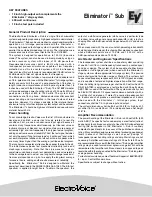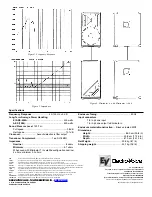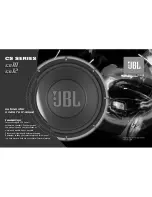
Eliminator i
™
Sub
KEY FEATURES
•
18 inch high-output sub complements the
Eliminator i
™
stage system.
•
400 watt continuous
•
18 inch steel pole included
General Product Description
The Electro-Voice Eliminator i
™
Sub is a single 18 inch subwoofer
system designed to produce very high-peak output musical material.
The Eliminator i
™
Sub can be used either in conventional biamplified
operation or in full-range passive mode with the Eliminator i
™
two-way high-peak output stage system in parallel. When used in
parallel, the combined impedance is 4 ohms. The internal passive
crossover consists of low-pass filter to the 18-in. DL18BFH.
The system is designed for operation up to 100 Hz (in passive
mode). The system can also be used in biamp mode by using an
active crossover system with slopes of 24 dB per-octave.
Recommended crossover point is 80 Hz when used with a
loudspeaker processor/crossover capable of low frequency
protection; or, as this is a vented system, a 40 Hz low frequency
filter of at least 3rd or 4th order is recommended (18 dB/ octave to
24 dB/octave) to filter out signals below that frequency.
The Eliminator i
™
Sub includes a top-mounted stand adapter and
an 18 in. pole mount for use with the Eliminator i
™
full-range system.
Safety concerns limit the use of a pole greater than 18 inches in
length (under no circumstances should a pole of greater than 18
inches be used with the Eliminator i
™
Sub). The DL18BFH woofer
will provide average power handling ratings of 400 watts EIA and
peak power ratings of 800 to 1000 watts. The system input
connections are 1/4-in. phone. Vented enclosures offer excellent
power handling and low distortion in the lowest octave of rated
operation. However, it is always advisable to filter material below
enclosure tuning to further improve system output and headroom.
The Eliminator i
™
should be high-pass filtered to reduce subsonic
material below 40 Hz.
Power handling
To our knowledge, Electro-Voice was the first U.S. manufacturer to
develop and publish a power test closely related to real-life
conditions. First, we use a random-noise input signal because it
contains many frequencies simultaneously, just like real voice or
instrument program. Second, our signal contains more energy at
extremely high and low frequencies than typical actual program,
adding an extra measure of reliability. Third, the test signal includes
not only the overall “long term average” or “continuous” level–which
our ears interpret as loudness–but also short-duration peaks which
are many times higher than the average, just like actual program.
The long-term average level stresses the speaker thermally (heat).
The instantaneous peaks test mechanical reliability (cone and
diaphragm excursion). Note that the sine wave test signals
sometimes used have a much less demanding peak value relative
to their average level. In actual use, long-term average levels exist
from several seconds on up, but we apply the long-term average
for several hours, adding another extra measure of reliability.
Specifically, the Eliminator i
™
Sub is designed to withstand the
power test described in the ANSI/EIA RS-426-A 1980. The EIA test
spectrum is applied for eight hours. To obtain the spectrum, the
output of a white-noise generator (white noise is a particular type
of random noise with equal energy per bandwidth in Hz) is fed to a
shaping filter with 6-dB-per-octave slopes below 40 Hz and above
318 Hz.
When measured with the usual constant-percentage bandwidth
analyzer (one-third-octave), this shaping filter produces a spectrum
whose 3-dB-down points are at 100 Hz and 1,200 Hz with a
3-dB-per-octave slope above 1,200 Hz.
Architects’ and Engineers’ Specifications
The loudspeaker system shall be a subwoofer system consisting
of one 45.7-cm (18-in.) low-frequency transducer in a vented quasi
band pass design. The system shall be capable of either biamp
operation or full-range passive (when used with the Eliminator i
™
stage system or other appropriate full-range system). The passive
mode shall provide first order low-pass filtering. The system shall
have a rated frequency response of 40 Hz to 100 Hz (passive mode)
and is capable of extended high-level operation within that range.
Power handling (long-term average) shall be 400 watts when EIA
RS-426-A 1980 is employed as a test method or 500 watts when
AES 1984 is used at the test method. The system sensitivity shall
be 98 dB (101 dB with 1/2 space load-common orientation) with a
1 watt input at a distance of 1 meter. The nominal impedance shall
be 8 ohms and shall produce a combined impedance of 4 ohms
when used with the Eliminator i
™
, full-range system. Input
connections shall be 1/4-in. phone input and output .
The system dimensions shall be 85.4 cm (33 5/8 in.) high by 42.9
cm wide (16.9 in.) and 60.9 cm (24 in.) deep and have a net weight
of 87 lb.
Amplifier Recommendation
The power handling of the Eliminator i
™
Sub is 400 watts EIA (500
watts AES). The specific tests used employ a crest factor (ratio of
peak energy to continuous energy) of at least 6 dB. During extended
testing the loudspeaker in the Eliminator i
™
Sub is routinely
subjected to peak levels far in excess of the published continuous
rating. Many amplifier designs are capable of producing peak power
levels in excess of their ratings as well so exact “pairings” of
loudspeaker power handling ratings and amplifier ratings are not
necessary. Amplifier continuous ratings of 400 watts to 800 watts
are recommended for use with the Eliminator i
™
Sub. Larger amplifier
ratings may be used for maximum dynamic range but it should be
remembered that amplifier continuous levels (as opposed to peak
levels) be within the range quoted for the Eliminator i
™
Sub long-term
average power handling.
For technical assistance, contact Technical Support at 866/78AUDIO
8 - 5 p.m. Central Standard time.
Specifications subject to change without notice.




















